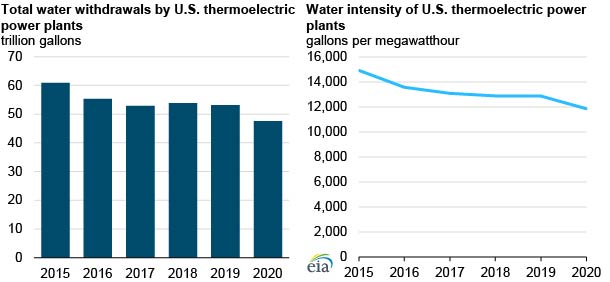
The U.S. electric power sector’s cooling water withdrawals fell 10.5% from 53.1 trillion gallons in 2019 to 47.5 trillion gallons in 2020, continuing the downward trend in withdrawals. The decline has been driven by the increased use of renewable and natural gas-fired generation in place of coal-fired generation, as well as less use of once-through cooling technologies.
As the fuel mix has shifted to less water-intensive energy sources, the water intensity of U.S. power generation—the average amount of water withdrawn per unit of electricity generated—has declined from 14,928 gallons per megawatthour (gal/MWh) in 2015 to 11,857 gal/MWh in 2020.
U.S. thermoelectric plants are the largest source of U.S. water withdrawals, accounting for more than 40% of total U.S. water withdrawals in 2015.

The changing U.S. electricity generation mix (in which coal-fired generation has decreased and natural gas-fired and renewable generation has increased) accounts for approximately 80% of the downward trend in water withdrawals by the electric power sector.
Natural gas-fired generation uses a more energy-efficient technology to produce electricity than coal and has a lower water withdrawal intensity than coal. Natural gas combined-cycle generation had an average water withdrawal intensity of 2,793 gal/MWh in 2020, compared with 21,406 gal/MWh for coal.
The share of renewable generation, which on average has a very low water withdrawal intensity, also significantly increased from 2015 to 2020.
The remaining 20% of water withdrawal reductions came from the reduced use of once-through cooling systems. Once-through cooling systems require significantly more water withdrawals than closed-loop recirculating and dry or hybrid cooling systems. Between 2015 and 2020, once-through cooling systems declined from 27% of thermoelectric net generation to 23%. Closed-loop systems made up 66% of net generation in 2020, and dry or hybrid cooling systems made up 7%.











